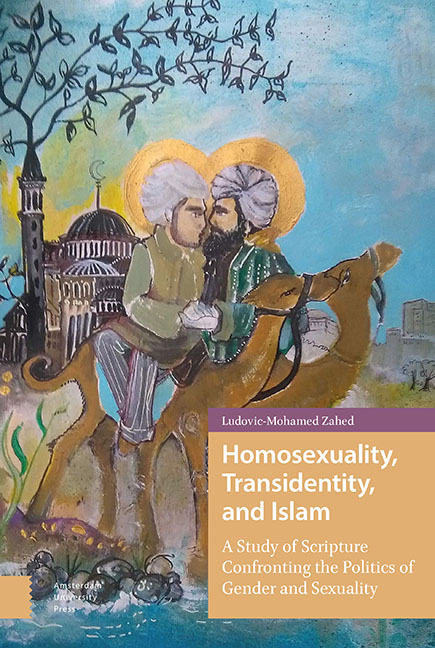 Homosexuality, Transidentity, and Islam
Homosexuality, Transidentity, and Islam Book contents
- Frontmatter
- Contents
- List of Figures
- Acknowledgments
- Foreword
- Introduction
- I The Qur’anic Ethics of “Nature”: Gender, Sexuality, and Diversity
- II Distressing Qur’anic Verses?
- III The Prophet: A Living Incarnation of Qur’anic Ethics
- IV Islamic Apocrypha Advocating the Stoning of “Sodomites”
- V Postcolonial Orientalisms
- VI “Abnormals”: From Cultural Diversity to Dogmatic Uniformity
- VII Towards a Structural Reevaluation of Cultural Values
- VIII Pan-Arabist Literary and Identity Censorship
- IX Orientalist Shi’ism and Literary Homoeroticism
- X Homonationalism and Performative Sexual Categorization
- XI A “Crisis” of Categories, Geopolitics or Civilization
- Conclusion
- Afterword
- Bibliography
- Index
Afterword
Published online by Cambridge University Press: 20 November 2020
- Frontmatter
- Contents
- List of Figures
- Acknowledgments
- Foreword
- Introduction
- I The Qur’anic Ethics of “Nature”: Gender, Sexuality, and Diversity
- II Distressing Qur’anic Verses?
- III The Prophet: A Living Incarnation of Qur’anic Ethics
- IV Islamic Apocrypha Advocating the Stoning of “Sodomites”
- V Postcolonial Orientalisms
- VI “Abnormals”: From Cultural Diversity to Dogmatic Uniformity
- VII Towards a Structural Reevaluation of Cultural Values
- VIII Pan-Arabist Literary and Identity Censorship
- IX Orientalist Shi’ism and Literary Homoeroticism
- X Homonationalism and Performative Sexual Categorization
- XI A “Crisis” of Categories, Geopolitics or Civilization
- Conclusion
- Afterword
- Bibliography
- Index
Summary
Like many other LGBT+s who grew up in Muslim families,I never questioned the notion thatnon-heterosexuality and Islam were incompatible.This was, after all, what I heard from all theMuslims I knew – from family members, religiousteachers, and strangers alike. If indeed Islamunambiguously condemns homosexuality, as I and manysimilarly oriented friends and acquaintancesbelieved, then there could only be three options:reject Islam, repress our sexuality, orcompartmentalize these two seemingly contradictoryparts of our identity. In my experience (and basedon a likely unrepresentative sample of queer MuslimsI encountered in my late adolescence and earlyadulthood in Singapore), the third option waspredominant. How many times have I seen in a gay baron Saturday night the same person I saw on Fridayafternoon at the masjid? How many times have I been thisperson? Those of us who were able tocompartmentalize ethno-religious identity and sexualpractice had adopted a sort of personal “don't ask,don't tell” policy with ourselves. We would live outtwo different lives, become two different people,and frequent two different worlds, keeping these twoexistences as separate as possible and deferring anymeaningful reflection on our compartmentalizedlives.
I also encountered older queer Muslims who had spentyears – or even decades – in the proverbial closet,repressing their sexuality, keeping up appearances,often to tragic outcomes. One such closeted man wasmarried with children, no longer intimate with hiswife, seeing other men, while still experiencingself-hatred, and being blackmailed by a relative whostumbled upon his Grindr profile. He confided to methat he felt like he was living in hell. Though theexperiences of other repressed queer Muslimacquaintances were relatively less dramatic, all ofthem shared the same kinds of fears, anxieties, anddilemmas related to the threat that their sexualityposed to their ethno-religious identity andcommunity belonging. What makes this group differentfrom the “compartmentalizers” is that the latter,while segregating two presumably incompatibleaspects of their identity, were “out” to themselves,while the former remained closeted with themselvesand with others.
Finally, as an erstwhile believing Muslim and now anatheist, I am as well versed with the socialexperience of rejecting Islam as I am with therepression of and the compartmentalization ofsexuality.
- Type
- Chapter
- Information
- Homosexuality, Transidentity, and IslamA Study of Scripture Confronting the Politics of Gender and Sexuality, pp. 117 - 120Publisher: Amsterdam University PressPrint publication year: 2019


